As a restaurant owner, it’s tough to pick and choose a restaurant marketing strategy that is right. Regardless, we here at KlikNRoll believe that SEO is an important strategy that any business should invest in.
In this comprehensive SEO guide, we’ll go through what Restaurant SEO actually entails, its benefits and an actionable plan that you can follow step-by-step to make your success on search engines!
Table of Contents
What Exactly is Search Optimization (SEO) for Restaurants?
SEO for restaurants or restaurant search engine optimization boils down to making sure that search engines like Google, Bing, and Yahoo understand every aspect of your restaurant, from the most important things like your opening hours and address, all the way to your menus, prices, and what people think of your restaurant.
The good thing about traffic from search engines is that the search already intends to visit a restaurant (even if they don’t know what they want to eat yet).
This means that search engine traffic is on the “warmer” end, as opposed to traffic from Facebook ads – where people might not be interested in eating just yet.
For most restaurants, SEO comes in the form of mainly local SEO. Local SEO is exactly what it sounds like, to optimize your restaurant’s website or profile to rank higher for search phrases in a particular area.
Let’s say you want to find a restaurant but are unsure of what dining options you want. The first thing you’ll probably do is Google something like “Restaurants near [Insert Your Location]”, or maybe “Restaurants near me”.
If the searcher has a deeper intent like maybe they’re looking for a certain type of cuisine, using phrases like “Italian food near me”.
It’s almost always easier to rank for more specific keywords, which we will get into later in the article!
The good thing about traffic from search engines is that the search already intends to visit a restaurant (even if they don’t know what they want to eat yet).
This means that search engine traffic is on the “warmer” end, as opposed to traffic from Facebook ads – where people might not be interested in eating just yet.
For most restaurants, SEO comes in the form of mainly local SEO. Local SEO is exactly what it sounds like, to optimize your restaurant’s website or profile to rank higher for search phrases in a particular area.
Let’s say you want to find a restaurant but are unsure of what dining options you want.
The first thing you’ll probably do is Google something like “Restaurants near [Insert Your Location]”, or maybe “Restaurants near me”.
If the searcher has a deeper intent like maybe they’re looking for a certain type of cuisine, using phrases like “Italian food near me”.
It’s almost always easier to rank for more specific keywords, which we will get into later in the article!
Key Benefits of Restaurant SEO
SEO is something that all restaurants would benefit from if done right. One of the biggest and most obvious benefits is visibility on search engines like Google and increased customer foot traffic.
Imagine being on the first page of the local map pack or search results page (SERP), on a search query with over 5,000 people searching monthly.
For most industries, the first result will gain about 40% of the total clicks, which means you’ll get 2,000 visitors directly to your website or Google Business Profile.
Besides more foot traffic and visibility, restaurants also benefit from more online orders.
Including links to delivery platforms like DoorDash or UberEats or even your own delivery system, on your website or Google Business Profile can directly boost your sales and revenue.
SEO also helps businesses with their branding, as the more often you show up at the very top of Google, the better your brand is perceived!
A Practical Guide to Boost Your Restaurant’s SEO for Free!
1. Determine Your Search Engine Optimization Keywords & Segment Them
Before we get into anything, you’re going to choose your keywords and segment them. As we mentioned earlier, local SEO is all about optimizing for location-based local search.

Local keywords can be broken down into 4 categories (from most generic to most specific), which can be:
- Restaurant “Near Me”
- Restaurant in [City]
- [Cuisine] Restaurant “Near Me”
- [Cuisine] Restaurant in [City]
As you can see, the first keyword “restaurant near me” is the most generic, meaning the users are looking for a restaurant but are unsure which restaurant they want.
The last keyword “[Cuisine] Restaurant in [City] is the most specific, which they already know what they want and the chances of them visiting are pretty high. This is what we call a “longtail keyword”.
We recommend targeting the specific longtail keywords, as you’ll get the best chances for more visitors and have an easier time ranking for it!
A Free Way to Find Restaurant Keywords Using Keyword Research Tools
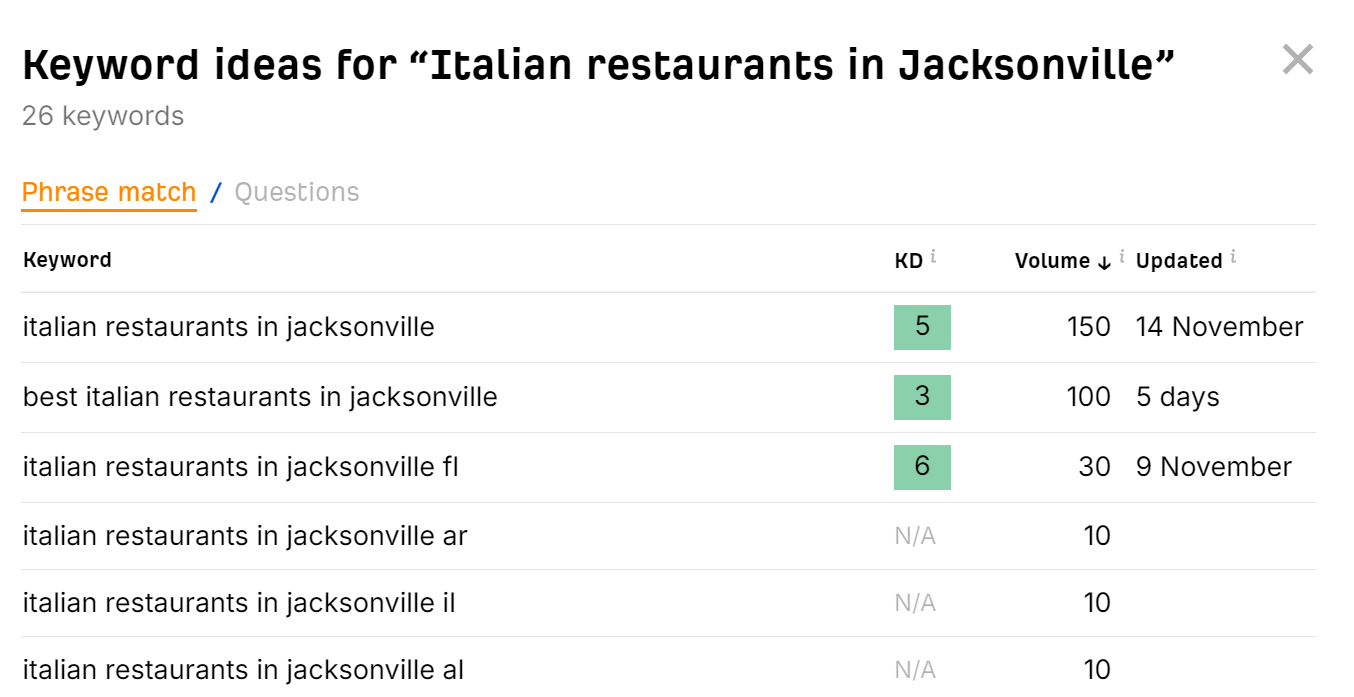
- Go to Ahrefs’s Free Keyword Generator Tool
- Make sure you’re under the “Google” tab and select your country.
- Next, type in your preferred longtail keywords like “Italian restaurants in Jacksonville”
- After that, you’ll see different variations of your keyword.
- Filter through the KD and Volume. KD stands for “Keyword Difficulty” and the higher the number, the more competitive it is for your restaurant to rank. Volume is essentially how many searches there are for that particular keyword every month.
- Find the exact keyword you want to target based on a balance of low difficulty and decent search volume. For this example, “Italian Restaurant in Jacksonville” is the best one since it has the highest search volume and it’s pretty low in difficulty.
Once you’ve got the keyword that you want to rank for, we want you to remember it. In the next few points, we’re going to go through exactly how you can go about targeting your primary keyword.
2. Optimize Your Google Business Profile (GMB)
Step 1: NAP (Name, Address, Phone Number)
By far the most important thing is to optimize your Google Business Profile (formerly known as Google My Business). The key is getting your NAP (Name, Address, and Phone Number) right.
Make sure your NAP is consistent across all your online channels, including social media platforms, third-party directories, etc. To make things easy for Google and other search engines, keep them the same across every single channel.
For example, if you usually use “Street”, use that on all your online platforms and try your best not to use variations like “St.” Remember: make things easy for Google and Google will make things easy for you!
Also, make sure the phone number is one that customers can contact you easily. Many customers might call to ask for a menu or book a reservation that way!
Step 2: Include as Much Information as Possible
The next step is to include as much information about your restaurant as possible. The more information you provide Google, the better your chances are for ranking for relevant keywords.
Here’s a checklist of the most important things to include:
- Opening Hours (Make sure it’s accurate)
- Address & Location
- Contact Info (Email, Phone Number)
- Photos (Food, menu, logo, interior and storefront)
- Include Special Features (Wheelchair Accessibility, Parking, etc.)
Step 3: Optimize Your Google Business Profile Description

Next, let’s talk about your restaurant’s description, arguably the most important piece aside from your NAP. Remember the keyword research bit we talked about earlier? This is where you should naturally optimize your business profile.
Here are some best practices that we’ve found that work for our clients:
- Use as much of the 750-character limit as possible.
- Key information like your preferred keyword should be in the first 200 words.
- Talk about your unique selling points and what makes your restaurant stand out from the competition.
- Keep your content unique, try not to write what you’ve already written on your website or any other platform.
3. Encourage Descriptive Reviews & Photos
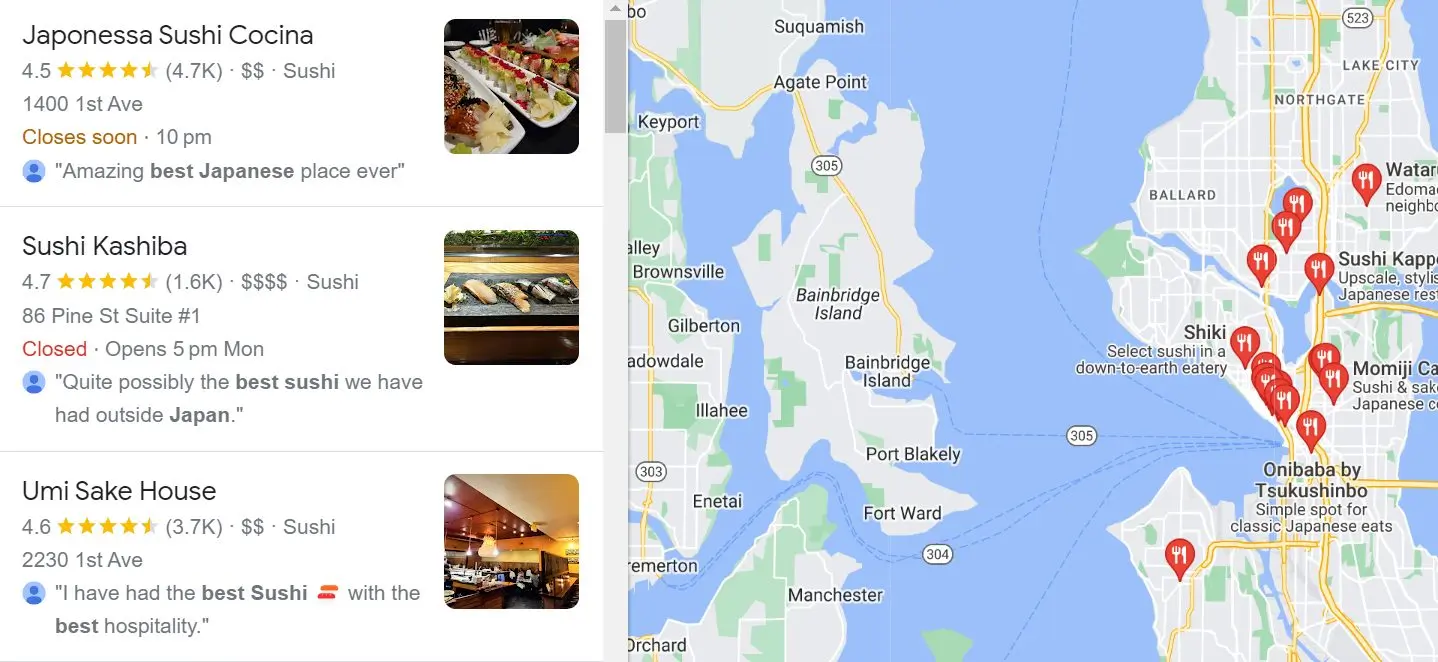
It’s no secret that reviews are important for any business, especially for the food and beverage industry.
If you search the keyword “Best Japanese Restaurant Seattle”, the top 5 results in the Google Map Pack tend to have many reviews (ranging from 1,600 to 4,700).
If you take a look at this article from Search Engine Journal, you’ll find that they’ve essentially hypothesized that reviews are a direct ranking factor, at least for the Google Map Pack.
Aside from better search rankings, the amount of positive reviews is also very important for conversion!
Another factor that many people overlook is the overall ‘quality’ of the review.
Though detailed reviews with photos are not a direct ranking factor, it’s still good to encourage your customers to be as detailed and include as many photos as possible as it can help with prominence and conversion!
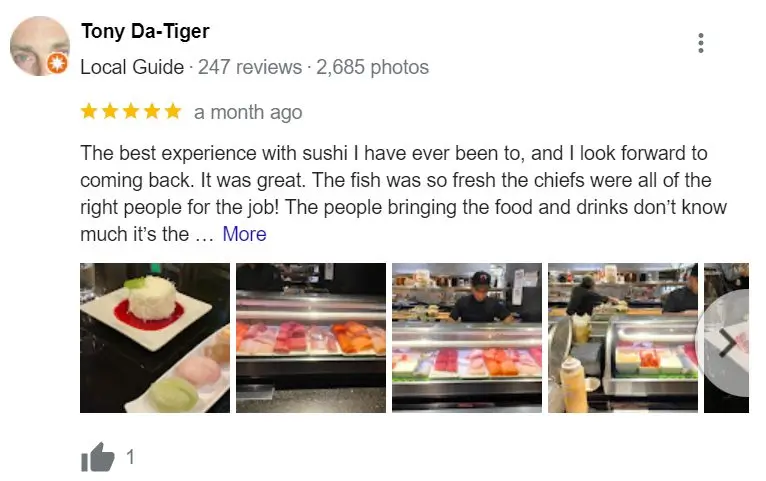
Bonus tip: Reviews left by ‘local guides’ are displayed first if it’s sorted by ‘relevance’. This can help with conversion as reviews are sorted by relevance by default.
It’s incredibly difficult or almost impossible to remove negative reviews, so the best thing you can do is to get a bunch of local guides to give good reviews to try and push negative ones down!
So on top of encouraging reviews, you should ideally also encourage them to join the Google Local Guide Program!
4. Create an Optimized Restaurant Website and Get the Basics Done
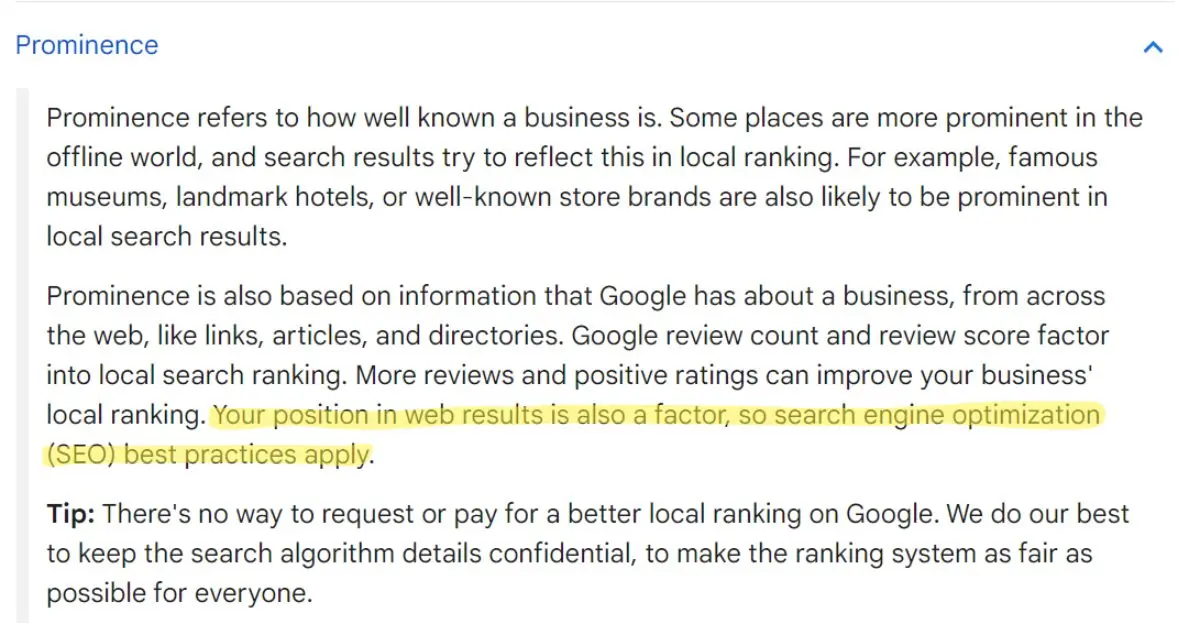
Many restaurants might not feel the need to get a website, but according to Google itself, your position on the web results is a direct ranking factor for restaurant SEO.
It doesn’t stop there, as a website can help restaurants’ conversion rate as it builds trust and directly helps with branding! Restaurant websites should include some key parts and pages to, again, build trust.
To make it simple for you, here is a checklist with pages to include on your website:
- Home Page
- About Page – Include opening hours,
- Footer – Make sure the NAP discussed earlier is accurately displayed in your footer (the same as your Google Business Profile)
- Location Page – discussed below.
Your website is also the main platform for how you can optimize for keywords. Remember the keyword research that we’ve talked about earlier?
Aside from the Google Business Profile, a location page is where the keywords should be for it to show up on Google Search. Now, this is the page that will show up for your target keyword, and as a bonus, you can also rank for “near me” queries if the searcher is nearby!
Here are the things to include in your restaurant website location page:
- Proper On-Page Structure (Appropriate H1, H2s, and H3s).
- Unique & Helpful Content Under Your Headings (Talk about your business and any business information relevant to local customers) – a good practice to adopt in the world of search engine optimization is to write unique content across all pages. Here’s a helpful article you can use to avoid duplicate content.
- Your NAP should be displayed prominently (link your address to your Google Business Profile – so that customers can find you easily).
- A Google Maps widget indicating exactly where your restaurant is. You can take a look at WordPress plugins to make it easy for you.
- Appropriate Structured Data/Schema Markup– To keep it simple, structured data or schema markup is code that allows search engines like Google to understand what your page is about. For restaurants, you would want local business structure data. This could get technical, so we recommend checking out Search Engine Journal’s guide for more information.
- A Call to Action (CTA) – Once they’re on your page, you want your visitors to take action and convert. This could be in the form of either booking a table online, directing them to an online ordering system, or maybe just submitting an inquiry. This is where you drive sales, bring in new guests and gain conversions.
Now, we understand that this is a lot to take in, especially for non-tech-savvy people. That’s why we at KlikNRoll offer services like these that are accessible.
We specialize in helping businesses with their SEO, as well as building online booking systems and online delivery platforms for restaurants! Some of our most well-known clients are the Murray Hotels (HK), Haagen Dazs, as well as McDonald’s and Pizza Hut!
If you want to learn more, click the button below to check out what we can do for you, and don’t hesitate to contact us!
5. Improve Prominence, Build Citations & White Hat Links for Search Engines
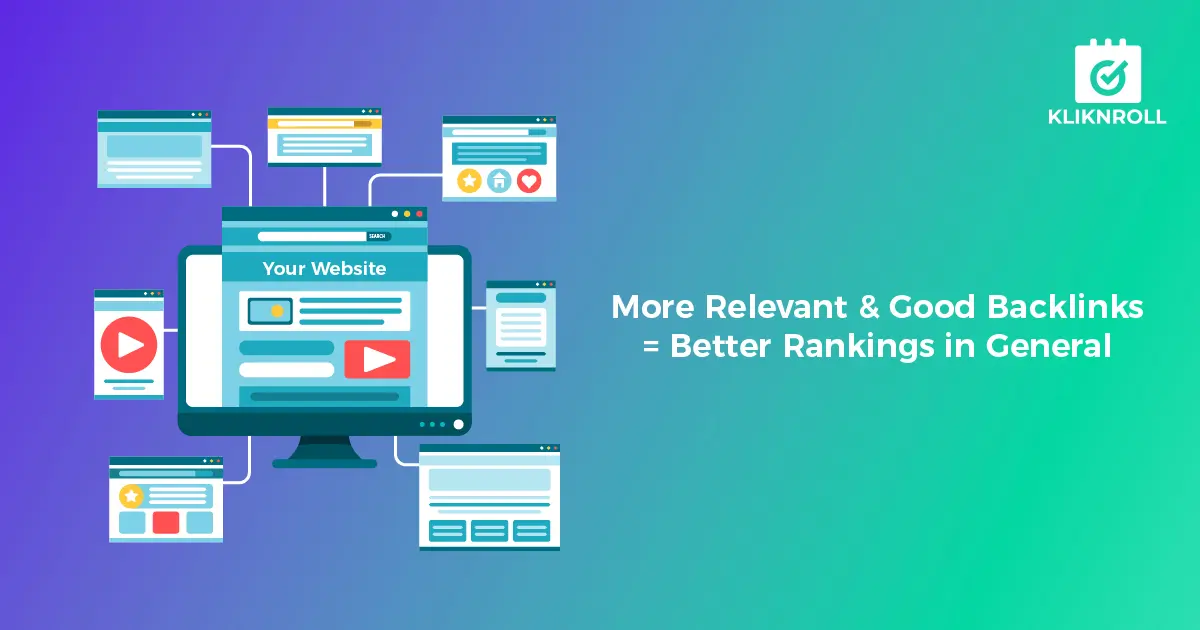
The next step is to build authority and trust with Google to rank better. Let’s take a look at Google’s local rankings documentation.
Prominence can also be based on information on the web, like links, directories, and articles.
This means that the more you’re talked about and featured on the internet, the more ‘prominent’ you are. Google measures this prominence, mainly by using links.
In the SEO world, we call this link building. Simply put, if a prominent website links to your website, the higher the chance that you can rank higher.
However, keep in mind that the keyword is prominent. If a spammy or sketchy website links to you, there’s a chance that it can hurt your search rankings.
That’s where white hat link building comes in. To keep it short, white hat link-building is the act of acquiring links from trusted sources in a natural way. The first and easiest thing you can do is to list your restaurant on online business directories.
In the restaurant business, you can opt for restaurant directories. To find some, simply Google “restaurant directory + your city”. Many city councils have their directories that you can sign up for.
You can also join your local chamber of commerce. Again do the same thing and Google “chamber of commerce + your city”, and click on the first one you see. If you live in a small town without a chamber of commerce, you can opt for signing up with the nearest one nearby.
Some directories will require you to pay an upfront fee or sign up for a membership. So, to see if it’s worth it, you can go to Ahref’s domain authority checker to determine that.
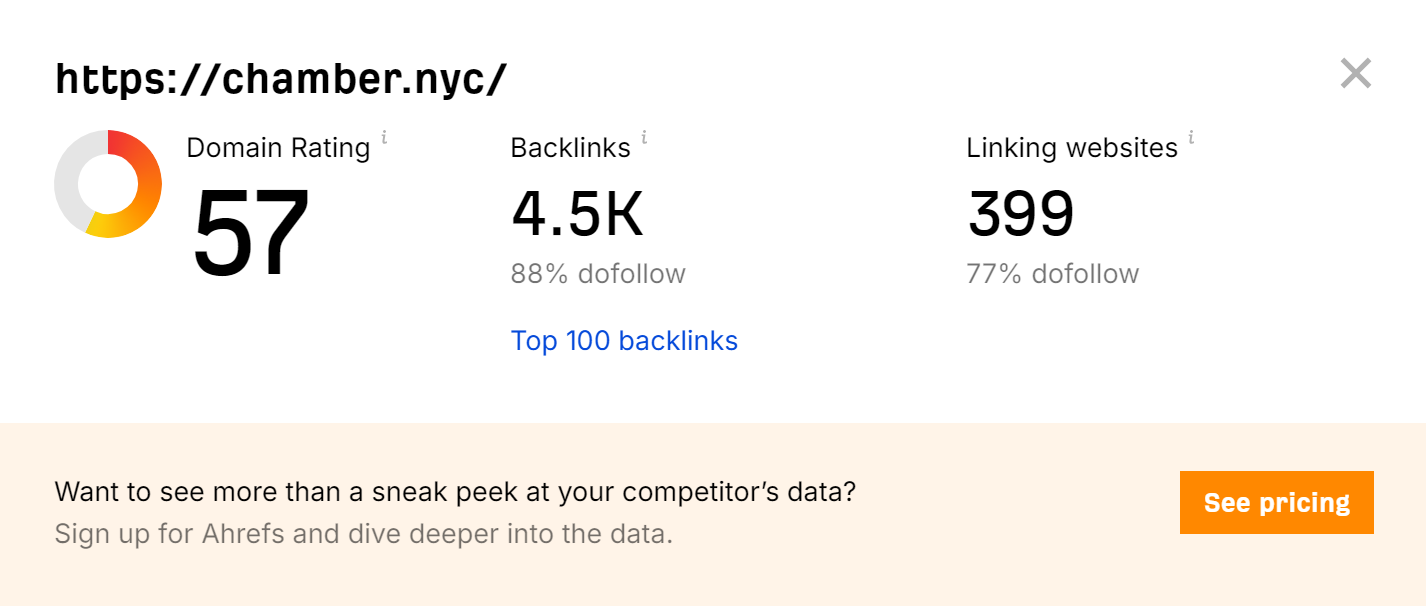
Simply type in the URL of the directory’s URL and the tool will come out with a number, which is their authority score. Generally, you’d want a score of at least 40, but the higher the better.
A prominent website will pass ‘link juice’ to your website and can be a significant ranking factor for your site’s restaurant SEO!
6. Work With Food Bloggers and Website Owners
Working with food bloggers and influencers sort of ties in with the previous point.
Let’s start with food bloggers, as they can directly help you in your SEO marketing efforts! Remember the earlier point where we talked about building white hat links and citations?
Well, working with food bloggers will also pass awesome link juice to your restaurant’s website.
If you Google queries like ‘best [cuisine] restaurant in [your city], you’ll see a number of them popping up in the search results page, alongside sites like TripAdvisor, Yelp, and OpenTable.
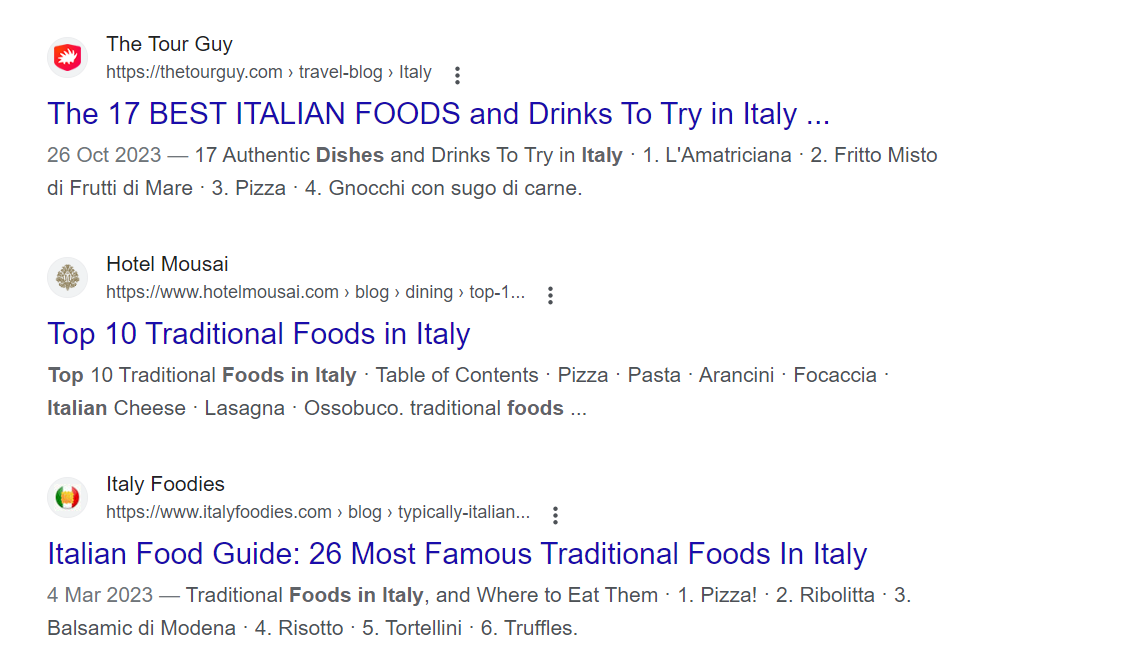
Many of these bloggers have been around for a long time and their sites are oftentimes high in ‘domain authority’.
You can have a brief look at their overall website authority score by using the same domain authority checker earlier!
While some will be kind enough to try out your restaurant for a review, most of them will negotiate a fee or affiliate commissions.
The most common way, in our experience, is through a monthly retainer, and the prices vary depending on where you live, the site’s overall traffic, post ranking, and domain authority.
Keep in mind that your position on their list costs more as well! A number 1 ranking on their list will no doubt cost more than the 5th, 7th, etc.
With the same principle as rankings on the search results page, position 1 is going to have more clicks and conversions compared to anything below it!
The key here is to negotiate with the food bloggers and get as much data as you can from their blog posts. If you’re a one-location restaurant, just being featured on one blog post is enough, e.g. “best Greek food in Seattle”.
Don’t be afraid to ask how much traffic their posts are getting monthly, how many clicks and conversions they get based on ranking, average search results ranking, etc.
Once you get enough data, then you can try negotiating based on what you think is right.
If you find that they get a lot of clicks versus the industry average, it might be a good idea to go by a flat retainer as opposed to paying per click.
The most important thing is to make sure that they link to your website, ideally your home page or your location page as we’ve discussed earlier!
If possible, try to negotiate for a “do-follow” link, as they directly pass link juice to your website.
7. Other Online Restaurant Marketing Strategies Benefits SEO Too
Besides food bloggers, you can also try to get in touch with TikTok or Instagram influencers.
They don’t impact your rankings directly but can be a great way to build ‘prominence’ as social signals are also pretty important for SEO.
According to Wordstream, having more social shares is more of an indirect indicator but can contribute to overall E-E-A-T (Experience, Expertise, Authority, and Trust).
Google has said many times that E-E-A-T is a direct ranking factor and having some sort of social media presence can help.
Generally, the same principles apply, get the influencers to link to your restaurant’s social media profiles, Google Business Profiles, or your website.
Other than that, having your social media profiles active is also a great way to boost trustworthiness.
Having a decent amount of followers, and posting content regularly on social media shows people (and Google) that you’re active – which is in our opinion, an indirect ranking factor.
8. Sponsor or Cater Local Events
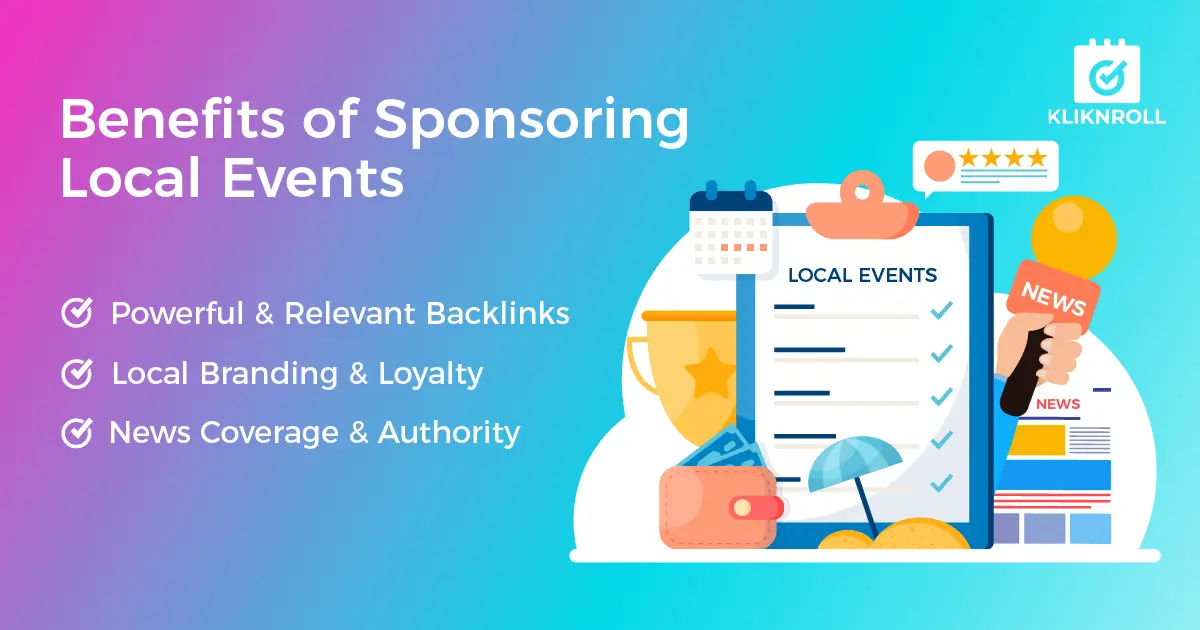
Aside from building a name in your community and improving local customer loyalty, sponsoring or catering events, sports games can be a big boost in your local rankings. Remember the whole E-E-A-T that we mentioned earlier?
Sponsoring or catering events can directly improve your website’s E-E-A-T. If people share more of your brand on social media platforms like Instagram, you can accumulate more ‘trust’ points in the eyes of Google.
Aside from that, sponsoring events will more likely than not give you a mention on the organizer’s social media platforms and website.
If you’ve paid attention to the earlier points, you’ll know that getting a mention on a website equals link juice!
Let’s say you’re catering an event for your local baseball team held at the Chicago Athletic Hotel. They happen to mention your website in one of their articles.
If you put their website in the domain checker tool mentioned earlier, they have an authority score of 60. This makes it an incredibly valuable backlink, which can boost your visibility on Google!
Sure, it might sting to sponsor events for free, but this is a long-term strategy that can pay off in the long run. It doesn’t just help your restaurant’s SEO strategy but helps you gain recurring and loyal customers.
Think of it like a loss leader strategy, you won’t turn a profit for catering but you do get more people to try your food and get your name out there. In the long run, you’ll gain more regulars and build a moat for your restaurant in your local community!
Conclusion - The Bottom Line
Unlike paid marketing channels like SEM and Facebook ads, SEO is all about playing the long game and building authority, prominence, and a moat that makes it hard for competitors to enter the market in your local location.
Despite taking a longer time and paying more upfront, SEO is a strategy that will net you, organic visitors, for free in the future!
To put it in perspective, it’s not going to take days and you might be required to go at this for at least a year, as most new websites get out of the Google Sandbox past that point.
The Google Sandbox is essentially a speculated filter that Google places on new websites in order to prevent spam or malicious users from messing up the search results. Google values user experience the most, so just keep that in mind!
If you’re wondering – yes, this guide works for any service-based industry!
If you need any help with building your website or SEO in general, feel free to come into contact with us and we’ll see what we can do for your restaurant! Just click the button below to get started!

Hey there! I’m Jeffrey Hau, and my journey in the digital world started after I wrapped up my psychology degree at UCLA. Imagine coming back to the bustling streets of Hong Kong from the tech haven of Silicon Valley – it was a whirlwind of inspiration! Seeing how social media platforms were evolving at breakneck speed and realizing the limitations of traditional advertising in this digital age, I decided to dive in.
In 2012, I laid the foundation of Prizm Group. From our humble beginnings, we’ve now blossomed into a global powerhouse with a team of over 200 passionate professionals. Our HQ is right here in Hong Kong, and we’ve spread our wings to SG, AU, NZ, JP, and China.
As a digital problem solver, our team found that several industries are in need of reservation systems, especially for F&B, Hotels, Beauty, and Medical sectors. Our digital magicians started crafting reservation systems tailored to cater to these specific needs. We extended our expertise to e-commerce, voucher management systems, and campaign management systems, combining them into KlikNRoll – an all-in-one solution. We deep dive into various industries, understanding their unique challenges and developing innovative solutions.
We’re not just a company; we’re your dedicated partners in transforming how you navigate the digital landscape. Our passion lies in providing businesses with intuitive and tailored solutions using KlikNRoll’s powerful capabilities.
Ready to embark on this exciting digital adventure with us? Let’s make your brand stand out in the digital jungle!






